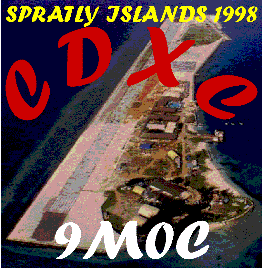 |
 |
The 9M0C operation closed down on Tuesday 24th February after making well
over 65k QSOs with over 180 DXCC countries.
The DXpedition was highly successful in every respect with all goals being
achieved. Full write-ups will appear in a number of the key magazines
including CQ Ham Radio (Japan), Radio Communication (UK), Funk (Germany),
etc.
9M0C presentations are also scheduled for Visalia, Dayton, Friedrichshafen,
the RSGB HF Convention, the Clipperton DX Club Convention, VERON (Netherlands)
and elsewhere.
We were able to run four high-power (400 watt) stations round the clock, each consisting of an FT-1000MP and VL-1000, a combination which worked seamlessly and flawlessly. Two further low-power (100 watt) operating positions using FT-920s enabled us to be on two additional bands at key times. One of these 920s was also used for 6m work when that band was open. Dunestar filters reduced inter-station interference to negligible levels. With only minor hiccoughs, we were also able to backup our logs in real-time to a central server, and to upload them daily to the Internet via a satellite link (the operating positions were linked by a "wireless-LAN" based on Timewave/AEA TNCs, and software developed for the DXpedition by G3WGV). The Internet log servers have already recorded well over 20,000 hits.
All antennas worked as expected, and several times we managed to operate SSB simultaneously with CW or RTTY on either 20 or 15 metres. Cushcraft antennas were used on the HF bands (10, 12, 17, 15, 20, 30) plus 6 metres, mostly at 30ft, though we did manage to erect the 20-3CD 20m monobander at 40ft, with great results (all were at the water's edge). On 40 and 80 we used four-square arrays based on Gladiator verticals, and switching/phasing boxes from Vine Antennas of the UK. The 40m array in particular worked extremely well, and 40 quickly became our preferred band for working over the toughest propagation path into Eastern US. The Titanex vertical was used mainly on 160, with great results on transmit, though we were constantly having to battle static from tropical storms on receive. The Battle Creek Special gave us a backup antenna for 80, allowing us to work both SSB and CW simultaneously at times. On 30m we also used a pair of phased verticals (one eighth wave apart), based on modified CB whips. This was very much an experiment, but proved to be highly successful.
We need to do some further analysis on the logs, but a preliminary breakdown is as follows (it's a pity US callsign allocations prevent us from doing an accurate split between call areas)(the numbers don't cross-check - we particularly need to reconcile 160 and RTTY figures - but should get a reasonable idea of the overall breakdown):
(QSO Data: 17.Mar.1998)
Mode 1.8 3.5 7 10.1 14 18 21 24.9 28 50 Total
CW 1149 2830 6554 5710 4635 3563 4529 3018 2048 262 34298
SSB 0 1420 4312 0 7511 2996 7282 2576 2632 127 28856
RTTY 0 0 0 0 1315 56 635 0 69 0 2075
FM 0 0 0 0 0 0 1 0 294 0 295
Total 1149 4250 10866 5710 13461 6615 12447 5596 5043 389 65524
Continent(Mode) CW SSB RTTY FM Total
Africa 115 195 4 0 314
Asia 11309 12438 823 290 24860
Europe 16844 9086 764 1 26695
North America 5345 5695 442 1 11483
Oceania 442 1120 33 3 1598
South America 243 322 9 0 574
(Britain 1182 646 22 1 1851)
Continent 1.8 3.5 7 10.1 14 18 21 24.9 28 50 Total
Africa 2 17 51 28 116 25 27 32 16 0 314
Asia 398 1497 3090 1268 4541 3038 5313 2442 2884 389 24860
Europe 567 1718 5501 3617 5100 2038 4283 2306 1565 0 26695
N.America 150 879 1927 695 2991 1320 2406 698 417 0 11483
Oceania 32 123 186 68 536 167 296 90 100 0 1598
S.America 0 16 111 34 177 27 122 26 61 0 574
(Britain 47 141 382 323 396 159 260 116 27 0 1851)
The overall QSO total places 9M0C in fourth position after VK0IR, 4J1FS and ZA1A which, along with our achievements on 160, RTTY, etc., we consider a good outcome for our first attempt at a major DXpedition. Our thanks to all our sponsors, details of whom have appeared in previous information bulletins and on our Web page (http://members.aol.com/spratly98). Without their help our plans would have had to be considerably less ambitious. The Web page also features some photographs, taken by digital camera and uploaded while we were still on the island.
QSLs cards will be printed at the earliest opportunity. A reminder that the
QSL manager is Phil Whitchurch, G3SWH, 21 Dickensons Grove, Conresbury,
Bristol, BS19 5HQ, England. Cards can also be sent via the bureau, or
requested by e-mail (phil@g3swh.demon.co.uk).
Don Field, G3XTT
g3xtt@lineone.net
This will probably be the last Press Release before our operation.
Everything is still on schedule, and much of our equipment has already
reached the island to await our arrival. We look forward to working
everyone from 9M0C.
We want to extend particular thanks to intrepid adventurers 9M6MN, 9M6HJ,
9M6II and 9M6SU who recently endured high seas and bad storms to make the
sea journey to Layang-Layang with our heavy equipment. While on the island
they achieved what we believe to be a "first", by setting up some 2m
equipment and working through the 9M6RGK repeater on Sabah to make QSOs
with 9M6JY & 9M6BZ. As far as we know, this is probably the first time that
VHF QSOs have taken place between Spratly and another DXCC country.
Note that for the propagation predictions to be readable, you need to view
this document in a non-proportional font. Please let me know if you need
copies of either of the previous two press releases.
Operators
Unfortunately Aki VK2BEX has had to withdraw from the operation, but we are pleased to say that his place has been taken by not one but three new operators:
John Krzymuski N2QW (ex-AB2EC). John is an experienced contest and DX operator who until his recent transfer to New York was active as G4DQW. John is a British citizen and has participated in numerous team efforts both domestically and overseas. John works in the USA as a Product Manager in a division of a global telecommunications co-operative.
Jeff Morris 9H1EL. Jeff is a holder of several European CQWW/WPX contest records on SSB and CW, and is also active in RTTY contests. He won BARTG RTTY spring contest last year, for example. Jeff is a retired Electronics/Systems Engineer working in the oil industry on positioning of Drillships by computer.
Kazuo Ogasawara JA1RJU. Kazuo is a Japanese national and an experienced operator who was most recently involved in the last BS7H DXpedition.
This takes our final team to 13, as follows:
Leader - Neville G3NUG
Deputy leaders - Don G3OZF & John G3WGV
Others - Ray G3NOM/9M2OM, Mike G3SED, Don G3XTT, Steve G4JVG, Tony G0OPB,
Kazuo JA1RJU, Vince K5VT, John N2QW, Jeff 9H1EL, Donald 9M6SU.
Shipping/Logistics
The nine cases shipped from the UK were successfully landed on Pulau
Layang-Layang by a fishing trawler on 21 January (see above). All the Yaesu
equipment is now in Kota Kinabalu - we will take this with us on our
flights to the island on 8 and 10 February. A final air-shipment comprising
mainly the hand-helds and TNCs for the newly developed DXpedition cluster
leaves the UK during w/c 26 January. The Battle Creek will arrive in KK in
the next day or so. Everything has gone to plan so far..........
John G3WGV has also compiled an extensive Operating Manual which will be
the basis for our activities on the island. It covers everything from
shipping lists and antenna layouts, to pile-up handling. In compiling it,
we have taken a lot of good material from the VK0IR operating handbook, as
that expedition did a lot to set standards for others to follow.
Pilot Stations
As we said in the last set of information, three pilot stations have been appointed. These are:
Europe: Martin G3ZAY (spratly@dial.pipex.com)
North America: Don N1DG (n1dg@aurumtel.com)
Japan: Yoichi JP1NWZ (jp1nwz@cqpub.co.jp)
Their role will be to channel communications to and from the team on the
island (which will be equipped with a satellite telephone, as there have
been some problems recently with incoming telephone calls to the
Layang-Layang resort). Typically, they will receive comments about band
openings, the suitability of the announced frequencies, brickbats and
bouquets from the amateur community at large, and will summarise the key
messages to forward to the island. This is to avoid information overload on
the expeditioners, and yet ensure that we have a good idea of what we are
doing right and what we are doing wrong. We will also be able to pass
information out to the pilots and Martin, G3ZAY, as Chief Pilot, will have
the job of keeping our Web site (http://members.aol.com/spratly98) updated.
Hopefully, this will also include photographs (we are taking a digital
camera).
Log checking via the Web
We plan to upload logs to the Web on a daily basis. This will not include
full QSO information, but will allow you to check that your QSOs were OK.
The service will be organised for us by Don N1DG (ex-WB2DND) who did the
same for the Heard Island expedition, and by Richard, G4ZFE who has also
run servers for DXpeditions. To check the logs, you need to go to the
DXpedition home page at http://members.aol.com/spratly98 and select one of
the two "am I in the log" servers. Generally you should select the one
that is nearest to you. There are servers in the UK and in USA. Once at
the server screen, simply type in your callsign and a list of QSOs will
appear.
News on Sponsors
We are delighted that there are several new sponsors since our last press release. The list as of 28th January is as follows:
Corporate Amateur:
AEA Timewave
CQ Ham Radio Magazine (Japan)
Cushcraft
Dunestar
Gladiator Verticals
Martin Lynch and Son (UK)
Nevada Communications (UK)
Radio Active Publications (UK)
The 5(9)Report
Yaesu
Corporate Non-Amateur:
Camel
Malaysian Tourism Promotion Board
Layang-Layang Resort Ltd.
Sabah Tourism Promotion Corporation
DX Associations, Clubs & Foundations:
Arkansas DX Association
Battle Creek DX Group
CDXC of UK
Central Arizona DX Association
Clipperton DX Club (France)
Dateline DX Association
EuDXF (Germany)
German DX Foundation
GM DX Group
INDEXA
LA-DX-Groups
NCDXF
OKDXA
RSGB Expedition Fund
Individuals:
G2FNK
G3JNB
G3PEM
G3OFW
G3PMR
GW4VEQ
JH1AJT
NI6T
VK5WO
XE1CI
And, of course, the Layang-Layang team members themselves who are all making significant contributions to the overall cost of the operation.
We also want to thank the following off-site team members for undertaking a
range of duties, missing out on the glory but taking on the chores!
BRS32525 Bob - SWL QSL Manager
G3SWH Phil - QSL Manager
G3ZAY Martin - Chief Pilot, EU Pilot and Web Master
G4PDQ John - EU PacketCluster Server
G4ZFE Richard - EU QSO Server
JP1NWZ Yoichi - JA Pilot
N1DG Don - NA Pilot and NA QSO Server
Given the higher-than-anticipated shipping costs, we are continuing to seek funding. Contributions may be sent to G3WGV (g3wgv@aol.com), JP1NWZ (jp1nwz@cqpub.co.jp) or K5VT (vince@getnet.com). G3WGV's mailing address is Canberra Lodge, Heath Ride, Finchampstead, RG11 3QJ, England.
QSLing policy
Much of the design work for the QSL card is complete, and we hope to get
cards out soon after the operation is over. All QSL requests go to G3SWH.
As we have said before, the expedition will respond 100% to QSLs received,
both direct and via bureau. E-mail QSL requests may also be sent to
phil@g3swh.demon.co.uk (give full QSO details please). Phil's mailing
address is Phil Whitchurch, 21 Dickensons Grove, Congresbury,
Bristol, BS49 5HQ, United Kingdom.
The Expedition plans to adopt the following policy with regard to direct
QSLs, and encourages all direct QSLers to adhere as closely as possible to
speed things up:
a) A self addressed envelope (SAE) should be provided.
b) Applications from EU and non EU countries should enclose at least
one IRC.
c) Applications from non European countries should enclose at least $1
or two IRC's.
d) Cards for applicants not enclosing an SAE and adequate reply paid
postage will be answered by surface mail or via the bureau as appropriate
Awards
Amateurs chasing the RSGB Supreme Commonwealth Award might like to note that this requires at least one contact with every Commonwealth call area. This includes Spratly under the 9M prefix, as this is a separate call area to 9M6.
And the latest Press Release from ARRL, regarding the revised rules for
DXCC, included the following:
"The Spratly Islands, due to the nature of conflicting claims, and without
recognising or refuting any claim, is recognised as a Special Entity.
Operations from this area will be accepted with the necessary permissions
issued by the occupying Entity. Operations without such permissions, such
as with a self-assigned (e.g. 1S) callsign, will not be recognised for DXCC
credit."
This emphasises the importance of obtaining operating permission from the relevant authority, in our case the Malaysian licensing authority.
After it's over..
Once we are home again, I will be sending out some further information to
those on my mailing list, and we will be writing articles for the major ham
radio publications including the Japanese CQ Magazine, the German Funk
Amateur and, of course, RSGB's RadCom. We are also scheduled to present at
the Visalia Convention, the RSGB Convention in October, and no doubt at
many other venues too including, we hope, Dayton. Nevada Publications of
the UK have also commissioned us to write the book of the expedition. Guess
we're going to be busy for some months yet!
See you from Spratly!
73 Don G3XTT, NK1G
g3xtt@lineone.net
A multinational group of DXpeditioners, primarily members of the UK's CDXC (Chiltern DX Club), the UK DX Foundation, will operate from Layang Layang Island in the Spratlys in February 1998. The operation will run from 12th to 24th February 1998, allowing two full weekends on the island and is timed to take place soon after the island re-opens to visitors following the typhoon season, in order to maximise the opportunities for good LF propagation. It is also hoped that sunspot numbers will by then have started to increase, and that the expedition will enjoy favourable HF propagation.
The team is expected to include G3NUG G3OZF G3SED G3WGV G3XTT G4JVG G0OPB K5VT VK2BEX 9M2OM(G3NOM) and 9M6SU. It is planned to keep four stations on the air round the clock, to maximise band openings. All HF bands will be activated, on SSB, CW and RTTY, and the group will also have equipment for 6 metres. The team will use a wide selection of monoband and multiband antennas including four-square arrays for both 40 and 80 metres. The callsign will be 9M0C.
Layang Layang (also known as Swallow Reef) has been the location for a
number of Spratly expeditions, including 9M0S and 9M0A. The island has been
developed by Malaysia as a dive resort, and has permanent accommodation,
mains power and an airstrip. The Spratlys currently rank at number 25
worldwide in the latest (Jan/Feb 97) DX Magazine poll, and 12th for East
Coast USA. They also rank 18th in the digital "Most Wanted" list (AA5AU).
Layang Layang is also in Zone 26, one of the rarest zones on the LF bands,
and therefore in great demand. The Spratly Islands count for AS-051 in the
RSGB's popular Islands on the Air Programme.
The DXpedition team includes veterans of many DX and contest operations,
with wide experience of both the LF and HF bands, and of all modes. It is
intended to make significant use of computer and Internet technology to
make information available about the expedition and to expedite QSLing
after the event. QSO data will be uploaded to the Internet while the
expedition is in progress. A Web page is available at
http://members.aol.com/spratly98 with up-to-the-minute expedition news.
Pilot stations in Europe (G3ZAY), the US (N1DG) and Japan (to be announced)
will act as an interface to the team, in line with the recent practice of
other major expeditions. Phil Whitchurch G3SWH will be QSL manager, and
QSLs will be available through the bureau or direct. Phil's address is 21
Dickensons Grove, Congresbury, Bristol, BS19 5HQ, England. Bureau cards
will also be answered 100%.
We are delighted that Yaesu have already offered the use of HF and 6m radios. We will be taking 4 FT-1000MPs and 2 FT-920s. Yaesu have also helped with UHF transceivers for the packet network we are developing for the island, to link the operating positions. AEA Timewave and Nevada Communications have helped with TNCs for the packet network, and NI6T, a veteran of several major DXpeditions, will loan a specially-modified PK-232 for HF RTTY. Cushcraft, via Nevada Communications, will be providing the HF antennas, which include beams for 10, 15 and 20 metres and for the WARC bands. Gladiator will provide verticals for the low-band arrays. Leading UK amateur radio dealer, Martin Lynch & Son, will be supplying Westflex cable runs. The team has also accepted the offer of a Battle Creek Special antenna for the LF bands. Dunestar will be loaning us three sets of filters for all nine bands. The Malaysian Tourism Promotion Board has kindly agreed to help with the printing of QSLs and will sponsor a series of prizes and awards in connection with the expedition, details of which will be released later. Sabah Tourism Promotion Board and Reliance Pacific, owners of the Layang Layang resort, are also helping to support the operation.
In addition, a number of Clubs, DX Foundations and individuals have already made generous donations, and others will very much be welcomed to offset the substantial budget for the expedition (including aircraft charter to the island). The early supporters include the Radio Society of Great Britain, Northern California DX Foundation, Clipperton DX Club, JH1AJT, INDEXA, the Central Arizona DX Association and the European DX Foundation, to whom the team extends its thanks. All individual and corporate sponsors will be acknowledged on our Web pages and elsewhere.
Further details about the operation will be sent out as it becomes available. Additional sponsorship is being sought, and donations can be made to K5VT (USA), VK2BEX (Japan/Oceania) and G3WGV (elsewhere). If you wish to be e-mailed directly with information as it becomes available, send a message to the expedition's publicity officer Don Field G3XTT at g3xtt@lineone.net
(Annex A)
Operators
A Asahina (VK2BEX), an Australian citizen of Japanese ethnic background.
Atsu Asahina was on the 1993 Mellish Reef DXpedition and has recently
returned from a major amateur radio DXpedition to a Canadian offshore
island. He has also operated from Nauru and Willis. His Japanese language
skills will be of great benefit to our operation due to the relative
proximity of Layang Layang to Japan, with its numerous amateur radio
operators.
D F Beattie (G3OZF) British, an amateur radio contest operator, and President of the Chiltern DX Club - the UK DX Foundation. Don Beattie, a member of the Radio Society of Great Britain (RSGB) Management and 'Islands on the Air' (IOTA) Committees, has operated from numerous countries and island groups, including Pulau Pangkor. He has held a Malaysian visitor's amateur radio licence and works as Chief Executive (Personnel) for a major UK-based global organisation. Don has also recently become a member of the RSGB Council, the organisation's governing body.
A J Canning (G0OPB) British, with a Malaysian wife. A keen contest and DX operator, Tony knows Sabah well. He has many friends in the Malaysian amateur radio community and has held a temporary Malaysian amateur radio licence. A Chartered Engineer, Tony Canning's radio experience commenced with four years as a marine radio operator followed by three years of shore based maintenance work. He is now an Assistant Chief Engineer with Racal.
E N Cheadle (G3NUG) British, a member of the RSGB Management Committee, the HF Committee and the 'Islands on the Air' (IOTA) committee. Neville Cheadle, who is Chairman of the Chiltern DX Club, has a long connection with Malaysia, having been a senior partner in the Price Waterhouse management consultancy, and undertaken consulting assignments in Malaysia. He has also operated amateur radio from many of the Malaysian offshore islands.
M Devereux (G3SED) British, is internationally known for his 34 yrs work on 160 mtrs and more recently 6 Mtrs. He was part of the team that activated Jordan on 6 metres for the first time as JY7SIX in 1994. Mike was a member of the Camel Trophy Expedition Team providing global communications from remote parts of the world. During the past five years he has operated 160, HF and 6 metres from 9M6, LU, CE1, V31 and Jordan as JY8ED. Mike is a keen CW operator and member of the prestigious First Class Operators' Club. Professionally he is managing director of a UK based communications company and the publisher of a monthly Hobby Radio magazine.
D I Field (G3XTT) British, an internationally-known radio amateur, and amateur radio writer. He has taken part in amateur radio operations from a number of countries in Europe, Africa and North America, and also holds a US amateur radio licence. Don Field is also a member of the RSGB Management Committee, and an experienced contest operator. He is a senior manager for BT (British Telecom), in an international business development role.
R Gerrard (G3NOM/9M2OM) A British citizen, Ray Gerrard is a self-employed telecommunications consultant currently working and living in Malaysia. Ray has participated in a number of amateur radio operations in South East Asia, including Thailand, Bangladesh and Myanmar as well as from Malaysia. J R Linford (G3WGV) British, an experienced contest and DXpedition operator who took part in the 1993 Mellish Reef DXpedition. He is past Chairman of the local radio club and of the Chiltern DX Club. Also licensed in the USA, he is a member of the First Class Operators' Club, whose membership is limited to 500 world-wide. Professionally he is the Business Development Manager of a UK Public Telecommunications Operator. His computer networking skills will be used during the proposed DXpedition to keep track of contacts made and to maintain the DXpedition's databases on the World Wide Web.
D Soh (9M6SU) Malaysian. Donald Soh has been working with the Public Works Department, Sabah, for over 25 years. Originally trained as an electrician, he took up amateur radio ten years ago and obtained his first transmitting licence in 1988. He is a member of the Sabah Amateur Radio Society and has held several SARS committee posts over the years. He has been in the Boys' Brigade movement for 30 years and is now the Battalion President. He recently established an amateur radio station with the callsign 9M6SBC to promote the hobby amongst club members in Sabah.
S E Telenius-Lowe (G4JVG) British, full-time staff member of the RSGB and News Editor of the internationally influential magazine RadCom. Also an active contest operator and experienced in organising and operating on amateur radio DXpeditions to remote parts of the world. He was a member of a highly successful DXpedition to Mellish Reef in the Coral Sea in 1993 and has operated as VK9YG, but is perhaps best known for his three years as P29DX. Steve Telenius-Lowe operated from Pulau Pinang in 1996 and has held a Malaysian amateur radio licence.
Dr V Thompson (K5VT) US citizen and internationally-known DXpeditioner, Vince Thompson is the fourth member of the team who was also on the 1993 Mellish Reef DXpedition. More recently, he was amongst the first radio amateurs allowed to operate from Myanmar. Dr. Thompson is a leading gynaecological surgeon, specialising in oncology.
Equipment & Antennas
Yaesu are supplying six transceivers for the use of the DXpedition. There
will be four main operating positions, each equipped with an FT-1000MP, and
Dunestar filters to limit inter-station interference. Each operating
position will also have a PC for logging purposes, linked by low power UHF
link to the main log server (see Annex F for further details of the
innovative software system to be used). One of the four main operating
positions will be equipped with a modified PK-232 terminal unit for RTTY
operation, and second PK-232 will be available for back-up.
A fifth operating position, equipped with an FT-920, will be used primarily for 6m operation, and will run in beacon mode when there is no band opening.
A second FT-920 will be available as a back-up radio for any of the operating positions.
The antenna system is expected to consist of the following:
160m: Battlecreek Special vertical, which will also be a back-up antenna
for 80 and 40 metres.
80m: 4-square array of Gladiator vertical antennas.
40m: 4-square array of Gladiator vertical antennas.
20m: Cushcraft 3-element monoband Yagi
15/10m Two Cushcraft A3S multiband Yagis, one with extension for 40m.
30m: Phased verticals
30/17/12m: Cushcraft A3WS
6m: Cushcraft Yagi
A Butternut HF-6V vertical will serve as a general back-up antenna and for
monitoring propagation.
Antennas will be spaced as widely as possible to minimise station
interaction and, in some cases, allow simultaneous operation on both CW and
SSB on the same band. Something like 1km of co-axial cable will be used!
Band Plans
The following frequencies should be used as guidelines, and all are +/-
QRM. In any case, these frequencies are subject to comment by the DXing
fraternity, and may be changed before the DXpedition commences.
160: CW 1824, SSB 1845 80: CW 3502, SSB 3805 (QSX down) 40: CW 7002, RTTY 7035, SSB 7080 30: CW 10102 20: CW 14022, RTTY 14080, SSB 14195 18: CW 18072, SSB 18145 21: CW 21022, RTTY 21080, SSB 21295 24: CW 24892, SSB 24945 28: CW 28022, RTTY 28080, SSB 28495 50: CW 50102, SSB 50145All operations will be split up, with the exception of 80m SSB where the split may also be down to accommodate both EU and USA requirements. Please do not under any circumstances call on the DXpedition transmit frequency unless the operator clearly indicates that he has reverted to transceive.
Expedition Philosophy
The 9M0C DXpedition is being planned with the intention, to borrow a phrase
from a well-known beer advertisement, of "reaching the parts which other
Spratly expeditions have not reached". By taking the latest equipment, a
substantial amount of antenna hardware, and making effective use of
computer systems and the Internet, the target is to make at least 40,000
QSOs, with particular emphasis on specialist bands and modes, and on
reaching parts of the world (such as east Coast US) which have a difficult
propagation path to Spratly.
The operators will use split-frequency operation at all times, unless
pile-ups become minimal towards the end of the operation, and there will be
no list or net operations. The operators will endeavour to use best
practice at all times, including frequent station identification.
Logs will be posted regularly on the Internet (with help from Don
Greenbaum, N1DG) which, it is hoped, will minimise the problem of
"insurance" contacts.
QSLs will available at the earliest opportunity after the DXpedition, and
will be available direct (for direct requests) and via the bureau (for
cards received via the bureau). SWL cards will also be answered.
Special Interest Focus
The CDXC Layang Layang expedition plans to pay particular attention to
special interest activities including the low bands, the WARC bands, 6m,
and RTTY. With the potential to run 4 HF stations plus 6m simultaneously,
we should be able to accomplish this while, at the same time, satisfying
demand on the bread-and-butter bands of 20, 15 and 10 (which we hope will
be open to a number of parts of the world by then).
6m
On 6 metres, we will be using the new FT-920 transceiver, kindly loaned by
Yaesu, and capable of running 100 watts output. We will be using Yagi
antenna, and will maintain a beacon on 50.110MHz in order to alert distant
operators to band openings. G3SED, an experienced 6-metre DXer, will
oversee operations on this band.
LF Bands
We have several team members with extensive LF experience (G3XTT, for
example, has 220 countries worked on 160, and holds several records for CQ
WW Phone and CW contesting on 160). Although space on the island is
limited, we believe there is room to set up a four-square antenna for 40
metres, another 4-square for 80 metres, and a reasonable
vertical/inverted-L for 160. These antennas will, almost certainly, have to
serve for receiving as well.
We have paid particular attention to the successful LF activities of a
number of recent expeditions, especially the VK0IR operation, using
four-square vertical arrays from Gladiator, and several operations (P2 S2
VK9) by a German group using Titanex verticals, and intend to emulate their
success. By scheduling our operation early in the year, we expect good LF
propagation to all parts of the world, and expect to cover all sunrise and
sunset openings on all three LF bands throughout our stay on the island.
Beverage antennas will not be used as the layout of the island precludes
their use in the main directions. However, we are looking into other types
of directional receiving antennas for 160 metres.
RTTY
Several of the expedition members have extensive RTTY experience. K5VT,
VK2BEX, G3OZF and G3XTT are all long-time RTTY operators, with DXing,
contesting and expedition experience. We have been offered, by Garry NI6T,
the loan of a specially modified PK232, used by VK0IR and other major
expeditions. By siting our HF stations as far apart as possible within the
confines of the island, we hope to be able to run RTTY simultaneously with
operating at least one other mode on the same band. RTTY will not,
therefore, have to suffer in second place to SSB or CW.
Our prime band for RTTY operation will be 20 metres, but we will make use
of other bands as appropriate to ensure that every part of the world has
the possibility of making RTTY QSOs.
SPRATLY DXPEDITION SERVER
As part of the DXpedition's programme to optimise technology, the entire
area of logging has been examined closely. It is intended that all QSOs
made during the DXpedition will be immediately logged to computer and
innovative techniques have been devised to manage the logging process and
provide information in real time to the operators. This unique project has
resulted in the Spratly DXpedition Server, the rationale and objectives of
which are discussed below.
Introduction
Many DXpeditions have attempted, with greater or lesser success, to log
QSOs at several operating positions using computers and then merge the logs
into a consolidated, centralised log. Usually this has been done using the
de-facto standard CT. In more recent times the consolidated logs have
occasionally been made available in some form on the Internet, sometimes
even whilst the DXpedition is still in progress.
A number of factors have tended to limit the success of these experiments:
Most DXpeditions want to use laptops because of weight and space
considerations. Unfortunately, laptops are poorly equipped in terms of
serial ports Efew have more than one.
CT will work with two serial ports
in a "daisy chain" configuration but this is problematic in that failure of
any component in the chain signals failure of the network as a whole.
CT, whilst an admirable program for contesting does not really adapt fully
to DXpeditioning where, these days, there is a real prospect of making 50k
to 75k QSOs. The QSO database in CT is held in memory and this means that
substantial machines are needed to support a major DXpedition, since all
QSOs from all stations are held on all logging computers.
Most inter-computer links tend to be at RS-232 level, which has a generally
poor signal-to-noise performance resulting in problems when several kW of
RF are flying round in the vicinity.
The above observations prompted a reappraisal of objectives and
technologies, the results of which are presented below.
Objectives
1. The logging stations should be able to operate well with PCs in the
upper 286 or lower 386 class;
2. None of the PCs should need to be capable of supporting more than a
single serial port;
3. There should be no limit, within reason, on the number of QSOs that can
be logged, either at the logging station or elsewhere;
4. The entire system should have good immunity to RF fields;
5. The entire system should have few single points of failure of any type
and especially should have the absolute minimum of points of failure that
could cause loss of the entire system;
6. The system should be capable of collecting all logs and creating a
consolidated DXpedition log both during and after the DXpedition;
7. The system should be capable of creating log updates for upload to the
Internet;
8. The system should be able to provide operators with DXpedition-wide and
individual statistics, on-line from the operating position.
Basic principles
A separate "Server" is provided, into which all logging stations connect
via packet TNCs. The use of TNCs is a key component in the strategy as the
multi-stream capability of these units means that they can be employed as a
multiplexer, concentrating several data streams to a single COM port on the
server, thus meeting objective 2 above. The server software has been
developed by John Linford G3WGV, author of the popular TurboLog station
logging software.
Each logging station runs a modified version of TurboLog. TurboLog was
used in the VK9MM DXpedition in 1993, logging over 44,000 QSOs. The
modified version knows about the DXpedition server and works with it to
provide various DXpedition specific features. The logging stations connect
via packet TNCs and UHF radio links to the server.
The server provides the following major functions:
1. Automatic collection of QSOs, both at the time they are made, or, in the
event that the server has been off-line, in background "catch-up" mode;
2. Various statistical analyses which can be requested by the operators at
the logging stations;
3. Talks, announces and WWVs, precisely as per PacketCluster;
4. Maintaining DXpedition system time on all connected PCs;
5. Capability of uploading to the Internet using the QSO format devised for
the VK0IR DXpedition;
6. Provide each operator with details of band, mode, etc. in use at the
other operating positions.
The end result will be that log consolidation will happen in the
background, without intervention by the expedition operators, the software
at the same time allowing the operating positions to maintain contact by
means of "Talk" messages, etc. A range of queries of the main log database
will allow the team to identify successful propagation paths and band
openings.
The 9M0C expedition will provide a valuable test of the server software
which, it is hoped, can then be used by subsequent DXpeditions.
========
CDXC
(Chiltern DX Club)
The UK DX Foundation
Spratly Islands 1998
12-24 February 1998
Arrangements for our forthcoming 9M0C expedition to the Spratly Islands are
going well. Here is the latest information. This is the second bulletin I
have sent out. If you didn't get a copy of the first one (which went out
early November) and would like one, please let me know. Please take time to
check our Web pages for the latest developments. We anticipate putting out
one more information bulletin before our departure, with the final operator
list, propagation predictions, information about log checking via the
Internet and the latest status report.
73
Don Field G3XTT (expedition publicity officer, e-mail: g3xtt@lineone.net)
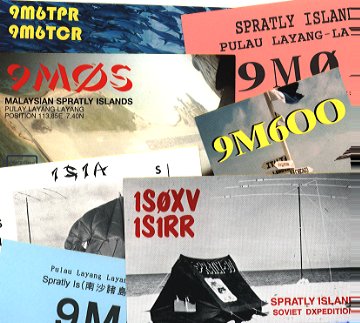 |
9M0C Flash ! |
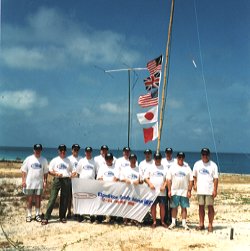 |
9M0C Flash ! |
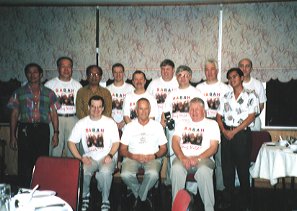 |
9M0C Flash ! |
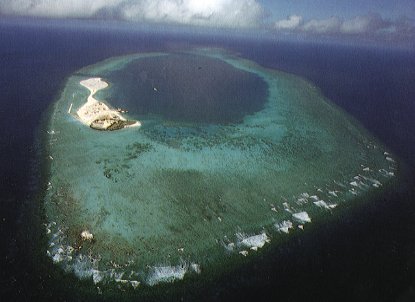 |
9M0C Flash ! |
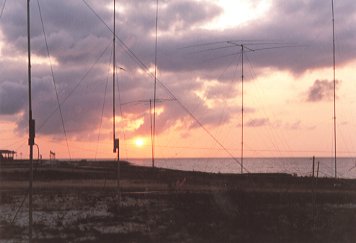 |
9M0C Flash ! |
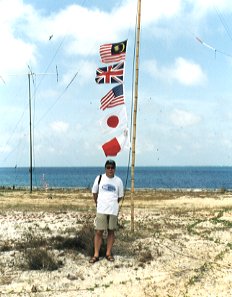 |
9M0C Flash ! |
